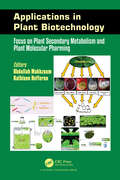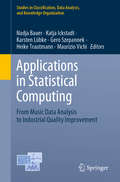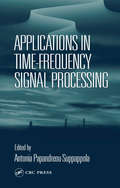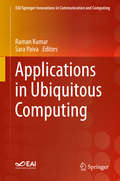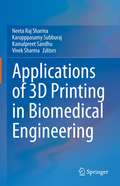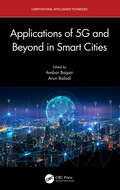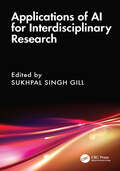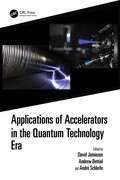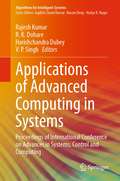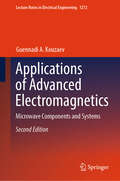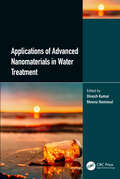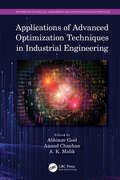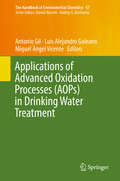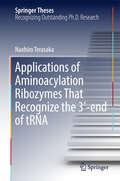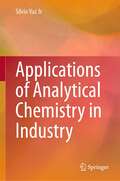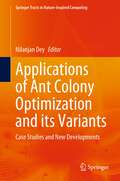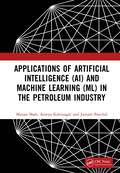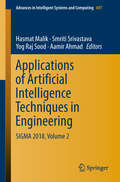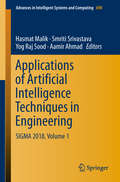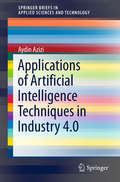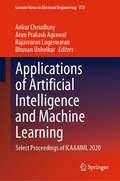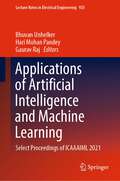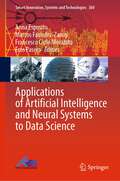- Table View
- List View
Applications in Plant Biotechnology: Focus on Plant Secondary Metabolism and Plant Molecular Pharming
by Kathleen Hefferon Abdullah MakhzoumThe book focuses on interesting topics in plant biotechnology and its applications. The first section covers a number of specific medicinal plants and their secondary metabolites using genetic and metabolic engineering. The pharmaceutical uses of these plant bioactive compounds and their applications in treating a variety of diseases including cancer, as well as recent works on in silico and bioinformatic analysis are described. The second section deals with innovative plant molecular pharming approaches and reviews the potential for using various plant host systems to design and produce effective new drugs to treat different illnesses and diseases such as HIV, infectious diseases, and other human and livestock diseases.
Applications in Recreation and Leisure: For Today and the Future (Fourth Edition)
by Kathleen A. CordesThis 4th Edition provides a contemporary examination of leisure issues from philosophical, psychological, and sociological perspectives. In examining leisure and recreation as human rights for all individuals, this text serves as a catalyst for critical thinking by students while providing a broad understanding of the different philosophies of the various providers of leisure services.
Applications in Reliability and Statistical Computing (Springer Series in Reliability Engineering)
by Hoang PhamThis book discusses practical applications of reliability and statistical methods and techniques in various disciplines, using machine learning, artificial intelligence, optimization, and other computation methods. Bringing together research from international experts, each chapter aims to cover both methods and practical aspects on reliability or statistical computations with emphasis on applications. 5G and IoT are set to generate an estimated 1 billion terabytes of data by 2025 and companies continue to search for new techniques and tools that can help them practice data collection effectively in promoting their business. This book explores the era of big data through reliability and statistical computing, showcasing how almost all applications in our daily life have experienced a dramatic shift in the past two decades to a truly global industry. Including numerous illustrations and worked examples, the book is of interest to researchers, practicing engineers, and postgraduate students in the fields of reliability engineering, statistical computing, and machine learning.
Applications in Statistical Computing: From Music Data Analysis to Industrial Quality Improvement (Studies in Classification, Data Analysis, and Knowledge Organization)
by Maurizio Vichi Heike Trautmann Karsten Lübke Nadja Bauer Katja Ickstadt Gero SzepannekThis volume presents a selection of research papers on various topics at the interface of statistics and computer science. Emphasis is put on the practical applications of statistical methods in various disciplines, using machine learning and other computational methods. The book covers fields of research including the design of experiments, computational statistics, music data analysis, statistical process control, biometrics, industrial engineering, and econometrics. Gathering innovative, high-quality and scientifically relevant contributions, the volume was published in honor of Claus Weihs, Professor of Computational Statistics at TU Dortmund University, on the occasion of his 66th birthday.
Applications in Time-Frequency Signal Processing (Electrical Engineering & Applied Signal Processing Series #10)
by Antonia Papandreou-SuppappolaBecause most real-world signals, including speech, sonar, communication, and biological signals, are non-stationary, traditional signal analysis tools such as Fourier transforms are of limited use because they do not provide easily accessible information about the localization of a given frequency component. A more suitable approach for those studying non-stationary signals is the use of time frequency representations that are functions of both time and frequency.Applications in Time-Frequency Signal Processing investigates the use of various time-frequency representations, such as the Wigner distribution and the spectrogram, in diverse application areas. Other books tend to focus on theoretical development. This book differs by highlighting particular applications of time-frequency representations and demonstrating how to use them. It also provides pseudo-code of the computational algorithms for these representations so that you can apply them to your own specific problems.Written by leaders in the field, this book offers the opportunity to learn from experts. Time-Frequency Representation (TFR) algorithms are simplified, enabling you to understand the complex theories behind TFRs and easily implement them. The numerous examples and figures, review of concepts, and extensive references allow for easy learning and application of the various time-frequency representations.
Applications in Ubiquitous Computing (EAI/Springer Innovations in Communication and Computing)
by Raman Kumar Sara PaivaThis book takes a deep dive into ubiquitous computing for applications in health, business, education, tourism, and transportation. The rich interdisciplinary contents of the book appeal to readers from diverse disciplines who aspire to create new and innovative research initiatives and applications in ubiquitous computing. Topics include condition monitoring and diagnostics; multi-objective optimization in design, multi-objective optimization of machining parameters, and more. The book benefits researchers, advanced students, as well as practitioners interested in applications of ubiquitous computing. Features practical, tested applications in ubiquitous computingIncludes applications such as health, business, education, electronics, tourism, and transportationApplicable to researchers, academics, students, and professionals
Applications of 3D printing in Biomedical Engineering
by Neeta Raj Sharma Vivek Sharma Karupppasamy Subburaj Kamalpreet SandhuThis book focuses on applications of three-dimensional (3D) printing in healthcare. It first describes a range of biomaterials, including their physicochemical and biological properties. It then reviews the current state of the art in bioprinting techniques and the potential application of bioprinting, computer-aided additive manufacturing of cells, tissues, and scaffolds to create organs in regenerative medicine. Further, it discusses the orthopedic applications of 3D printing in the design and fabrication of dental implants, and the use of 3D bioprinting in oral and maxillofacial surgery and in tissue and organ engineering. Lastly, the book examines the 3D printing technologies that are used for the fabrication of the drug delivery system. It also explores the current challenges and the future of 3D bioprinting in medical sciences, as well as the market demand.
Applications of 5G and Beyond in Smart Cities (Computational Intelligence Techniques)
by Ambar Bajpai and Arun BalodiThis book explores the potential of 5G technologies and beyond in smart city setups, with the availability of high bandwidths and performance, and low latency. The book starts with an introduction to 5G, along with the challenges, limitations, and research areas in future wireless communication, including the related requirements for transformation of societal paradigms and infrastructure. Applications related to visible light communication, network management in smart cities, the role of 5G in public healthcare, safety, security, and transportation, and existing and planned 6G research frameworks are included. The features of the book include: A broad perspective on 5G communications with a focus on smart cities. Discussion of artificial intelligence in future wireless communication and its applications. A systemic and comprehensive coverage of 6G technologies, challenges, and uses. The role of future wireless communications in safety, health, and transport in smart cities. Case studies of future wireless communication. This book is aimed at researchers and professionals in communications, signal processing, cyber-physical systems, and smart cities.
Applications of AI for Interdisciplinary Research
by Sukhpal Singh GillApplying artificial intelligence (AI) to new fields has made AI and data science indispensable to researchers in a wide range of fields. The proliferation and successful deployment of AI algorithms are fuelling these changes, which can be seen in fields as disparate as healthcare and emerging Internet of Things (IoT) applications. Machine learning techniques, and AI more broadly, are expected to play an ever-increasing role in the modelling, simulation, and analysis of data from a wide range of fields by the interdisciplinary research community. Ideas and techniques from multidisciplinary research are being utilised to enhance AI; hence, the connection between the two fields is a two-way street at a crossroads. Algorithms for inference, sampling, and optimisation, as well as investigations into the efficacy of deep learning, frequently make use of methods and concepts from other fields of study. Cloud computing platforms may be used to develop and deploy several AI models with high computational power. The intersection between multiple fields, including math, science, and healthcare, is where the most significant theoretical and methodological problems of AI may be found. To gather, integrate, and synthesise the many results and viewpoints in the connected domains, refer to it as interdisciplinary research. In light of this, the theory, techniques, and applications of machine learning and AI, as well as how they are utilised across disciplinary boundaries, are the main areas of this research topic. This book apprises the readers about the important and cutting-edge aspects of AI applications for interdisciplinary research and guides them to apply their acquaintance in the best possible manner This book is formulated with the intent of uncovering the stakes and possibilities involved in using AI through efficient interdisciplinary applications The main objective of this book is to provide scientific and engineering research on technologies in the fields of AI and data science and how they can be related through interdisciplinary applications and similar technologies This book covers various important domains, such as healthcare, the stock market, natural language processing (NLP), real estate, data security, cloud computing, edge computing, data visualisation using cloud platforms, event management systems, IoT, the telecom sector, federated learning, and network performance optimisation. Each chapter focuses on the corresponding subject outline to offer readers a thorough grasp of the concepts and technologies connected to AI and data analytics, and their emerging applications
Applications of Accelerators in the Quantum Technology Era
by David Jamieson André Schleife Andrew BettiolThis book explores new experimental techniques and theoretical models to deepen an understanding of radiation effects and ion interaction processes in order to design materials for devices for the emerging quantum technology era.Applications include tailored sensors that respond to ionizing radiation and other electromagnetic phenomena; sensors with high radiation hardness; and materials that contain specific engineered defects with desirable optical, magnetic, or electrical properties.The chapters detail direct experimental investigations into the dynamics of radiation-induced defects, including their generation, annihilation, and transformation, on a time scale ranging from femto-seconds to seconds which requires a more detailed understanding to develop the potential of ion beams for the new technology era.It will be a valuable reference for graduate students and researchers that employ ion beams and want to engage in quantum technologies. The book will also be of interest to scientists and engineers from industry that want to make use of ion beams in quantum technologies or learn more about the potential use of ion beams in the field.Key Features:• Provides a comprehensive introduction to this exciting and growing field of research.• Up-to-date with the latest cutting-edge research and practical guidance for researchers and those in industry to apply to their work.• Edited by established authorities, with chapter contributions from subject-area specialists.
Applications of Advanced Computing in Systems: Proceedings of International Conference on Advances in Systems, Control and Computing (Algorithms for Intelligent Systems)
by Rajesh Kumar Harishchandra Dubey V. P. Singh R. K. DohareThis book covers advances in system, control and computing. This book gathers selected high-quality research papers presented at the International Conference on Advances in Systems, Control and Computing (AISCC 2020), held at MNIT Jaipur during February 27–28, 2020. The first part is advances in systems and it is dedicated to applications of the artificial neural networks, evolutionary computation, swarm intelligence, artificial immune systems, fuzzy system, autonomous and multi-agent systems, machine learning, other intelligent systems and related areas. In the second part, machine learning and other intelligent algorithms for design of control/control analysis are covered. The last part covers advancements, modifications, improvements and applications of intelligent algorithms.
Applications of Advanced Electromagnetics: Microwave Components and Systems (Lecture Notes in Electrical Engineering #1272)
by Guennadi A. KouzaevThis book addresses microwave researchers, engineers, and Master's and Ph.D. students. It follows the idea of the first Edition to educate the readers on fundamental electromagnetics and show how this brilliant theory is used in developing modern multi-physics microwave and terahertz hardware. The first three chapters discuss the main ideas and methods of electromagnetism, explained in a manner that is clear for readers who have had some initial knowledge of electromagnetism. Chapters 4 and 5 are on transmission lines. The first text is on the integrated ones for digital applications, which have been working since DC up to several tens or hundreds of gigahertz. The next chapter is on the waveguides for terahertz frequencies. In this book, the space-modulated signals application, compared to the 1st Edition, is considered using the example of a novel predicate variable logic processor designed and verified in an FPGA environment (Chapter 6). This idea, born initially in microwaves, allowed an eight-logic-style re-configurable on-the-fly processor. Chapters 7–9 discuss microwaves in heating liquids and the initiation of rapid chemical reactions in novel miniature quasi-TEM wave reactors. Chapter 10 involves results on trapping and transporting ultra-cold matter using combined techniques. The new results described here are on numerical simulation of trapping of ultra-cold atoms in random 3D optical potentials using the Anderson effect. In conclusion, the author hopes this book will strengthen the young generation's interest in microwave field theory. He believes that advanced electromagnetism, combined with other physics branches, will play a crucial role in developing new, improved components and systems, and this book is a stepping-stone example in that journey.
Applications of Advanced Nanomaterials in Water Treatment
by Dinesh Kumar Meena NemiwalWater is the most vital substance in every aspect of life, and its contamination because of the activity of mankind poses a big global challenge. Addressing this issue for drinking purposes and environmental protection is the current big issue. Many research groups worldwide have been working on effective treatment technologies based on nanomaterials during the last two decades. Water and wastewater treatment by nanomaterial-based technologies has become an aid in finding possible solutions for contaminated wastewater released from various water sources. Nanoscale materials can be seen to take on unique and unpredictable properties that make them more robust, flexible, lighter, and faster, and the particular material used for the development of devices and systems. Features: • This book presents the use of different advanced nanomaterials to treat water and wastewater. • The uses of carbon-based nanomaterials, metal-organic frameworks (MOFs), and biopolymer-supported nanomaterials for water treatment are explored, focusing on new- generation materials. • Water purification methods such as the disinfection of water using green synthesized nanomaterials, adsorption through nanomaterial-based adsorbents, and nanofiltration techniques are discussed. We emphasize efficient water treatment methods and the use of new emerging nanomaterials in the toxicological study of nanomaterials. Nanomaterials provide high-performance and cost-effective treatment for water treatment. Various nanomaterials and electrochemical methods are used to stop, remove, or neutralize water harmful organic and inorganic contaminants in water through adsorption, filtration, and disinfection.
Applications of Advanced Optimization Techniques in Industrial Engineering (Information Technology, Management and Operations Research Practices)
by Abhinav Goel Anand Chauhan A. K. MalikThis book provides different approaches used to analyze, draw attention, and provide an understanding of the advancements in the optimization field across the globe. It brings all of the latest methodologies, tools, and techniques related to optimization and industrial engineering into a single volume to build insights towards the latest advancements in various domains. Applications of Advanced Optimization Techniques in Industrial Engineering includes the basic concept of optimization, techniques, and applications related to industrial engineering. Concepts are introduced in a sequential way along with explanations, illustrations, and solved examples. The book goes on to explore applications of operations research and covers empirical properties of a variety of engineering disciplines. It presents network scheduling, production planning, industrial and manufacturing system issues, and their implications in the real world. The book caters to academicians, researchers, professionals in inventory analytics, business analytics, investment managers, finance firms, storage-related managers, and engineers working in engineering industries and data management fields.
Applications of Advanced Oxidation Processes (The Handbook of Environmental Chemistry #67)
by Antonio Gil Luis Alejandro Galeano Miguel Ángel VicenteThis volume reviews the drinking water treatments in which AOPs display a high application potential. Firstly it reveals the typical supply sources and limitations of conventional technologies and critically reviews natural organic matter characterization and removal techniques, focusing mainly on AOP treatments. It then explores using AOPs for simultaneous inactivation/disinfection of several types of microorganisms, including highly resistant Cryptosporidium protozoa. Lastly, it discusses relevant miscellaneous topics, like the most promising AOP solid catalysts, the regime change of Fenton-like processes toward continuous reactors, the application of chemometrics for process optimization, the impact on disinfection byproducts and the tracing of toxicity during AOP treatments. This work is a useful reference for researchers and students involved in water technologies, including analytical and environmental chemistry, chemical and environmental engineering, toxicology, biotechnology, and related fields. It is intended to encourage industrial and public-health scientists and decision-makers to accelerate the application of AOPs as technological alternatives for the improvement of drinking water treatment plants.
Applications of Aminoacylation Ribozymes That Recognize the 3′-end of tRNA (Springer Theses)
by Naohiro TerasakaIn this thesis, applications of aminoacylation ribozymes named flexizymes are described. Flexizymes have the following unique characteristics: (i) substrate RNA is recognized by two consecutive base pairs between the 3'-end of substrate RNA and the 3'-end of the flexizyme; (ii) these base pairs can be substituted with other base pairs; and (iii) various activated amino acids can be used as substrates including both canonical and noncanonical amino acids. This flexible aminoacylation of RNAs by flexizymes was used to label endogenous tRNAs to be removed, and in vitro selection using the tRNA-depleted library enabled the discovery of the novel interaction between the microRNA precursor and metabolites. Flexizymes are also used to prepare various aminoacyl-tRNAs bearing mutations at the 3'-end to engineer the translation machinery and to develop the orthogonal translation machinery. The first part of the research demonstrated that SELEX is appropriate for discovering the interaction between small RNA and ligands, and suggested that more RNA motif binding to small molecules exists in small RNAs. The second part opened a door to new opportunities for in vitro synthetic biology involving the engineering of the genetic codes and translation machineries. This research also indicated the great potential of aminoacylation by flexizymes to be applied in various fields of RNA research, which is beneficial for RNA researchers.
Applications of Analytical Chemistry in Industry
by Silvio Vaz JrThis book deals with analytical techniques and methods applied in several sectors of technology and industry and serves as a concise and up-to-date reference for the practical application of analytical chemistry. Divided into 10 chapters, the book starts with an introduction to the fundamentals of analytical chemistry, followed by a review of modern analytical technologies and their application in different industrial sectors and activities such as agrochemicals and pharmaceuticals, ores and mining, polymers, biotechnology, and oil & gas. Particular attention is given to industrial environmental issues, where the author discusses the advanced analytical techniques used to provide quantitative information about pollutants in aqueous and gaseous effluents and their carbon footprint. The book finishes with a chapter summarizing the main remarks and conclusions on advanced analytical techniques used in different industrial sectors, as well as on topics of sustainability, and instrumental analysis. In this book, readers will find valuable insights, including real-life examples, of how classical and instrumental techniques can be used by industry, to help professionals in the quality control of raw materials, products and processes, in the assessment of the formulation contamination, environmental pollution and in the evaluation of sustainability, among others. Given its breadth, the book appeals to professionals (mainly chemists, biochemists, and engineers), researchers, professors, and graduate students.
Applications of Ant Colony Optimization and its Variants: Case Studies and New Developments (Springer Tracts in Nature-Inspired Computing)
by Nilanjan DeyThis book explains the basic ideas behind several variants of ant colony optimization (ACO) and shows how they may be used in real-world settings like manufacturing, engineering design, and health care. Marco Dorigo proposed ACO for the first time, and it has been used to solve a variety of optimization problems. This book presents the latest developments of ACO.
Applications of Artificial Intelligence (AI) and Machine Learning (ML) in the Petroleum Industry
by Manan Shah Ameya Kshirsagar Jainam PanchalToday, raw data on any industry is widely available. With the help of artificial intelligence (AI) and machine learning (ML), this data can be used to gain meaningful insights. In addition, as data is the new raw material for today’s world, AI and ML will be applied in every industrial sector. Industry 4.0 mainly focuses on the automation of things. From that perspective, the oil and gas industry is one of the largest industries in terms of economy and energy. Applications of Artificial Intelligence (AI) and Machine Learning (ML) in the Petroleum Industry analyzes the use of AI and ML in the oil and gas industry across all three sectors, namely upstream, midstream, and downstream. It covers every aspect of the petroleum industry as related to the application of AI and ML, ranging from exploration, data management, extraction, processing, real-time data analysis, monitoring, cloud-based connectivity system, and conditions analysis, to the final delivery of the product to the end customer, while taking into account the incorporation of the safety measures for a better operation and the efficient and effective execution of operations. This book explores the variety of applications that can be integrated to support the existing petroleum and adjacent sectors to solve industry problems. It will serve as a useful guide for professionals working in the petroleum industry, industrial engineers, AI and ML experts and researchers, as well as students.
Applications of Artificial Intelligence Techniques in Engineering: SIGMA 2018, Volume 2 (Advances in Intelligent Systems and Computing #697)
by Aamir Ahmad Hasmat Malik Smriti Srivastava Yog Raj SoodThe book is a collection of high-quality, peer-reviewed innovative research papers from the International Conference on Signals, Machines and Automation (SIGMA 2018) held at Netaji Subhas Institute of Technology (NSIT), Delhi, India. The conference offered researchers from academic and industry the opportunity to present their original work and exchange ideas, information, techniques and applications in the field of computational intelligence, artificial intelligence and machine intelligence. The book is divided into two volumes discussing a wide variety of industrial, engineering and scientific applications of the emerging techniques.
Applications of Artificial Intelligence Techniques in Engineering: Sigma 2018, Volume 2 (Advances In Intelligent Systems and Computing #697)
by Aamir Ahmad Hasmat Malik Smriti Srivastava Yog Raj SoodThe book is a collection of high-quality, peer-reviewed innovative research papers from the International Conference on Signals, Machines and Automation (SIGMA 2018) held at Netaji Subhas Institute of Technology (NSIT), Delhi, India. The conference offered researchers from academic and industry the opportunity to present their original work and exchange ideas, information, techniques and applications in the field of computational intelligence, artificial intelligence and machine intelligence. The book is divided into two volumes discussing a wide variety of industrial, engineering and scientific applications of the emerging techniques.
Applications of Artificial Intelligence Techniques in Industry 4.0 (SpringerBriefs in Applied Sciences and Technology)
by Aydin AziziThis book is to presents and evaluates a way of modelling and optimizing nonlinear RFID Network Planning (RNP) problems using artificial intelligence techniques. It uses Artificial Neural Network models (ANN) to bind together the computational artificial intelligence algorithm with knowledge representation an efficient artificial intelligence paradigm to model and optimize RFID networks.This effort leads to proposing a novel artificial intelligence algorithm which has been named hybrid artificial intelligence optimization technique to perform optimization of RNP as a hard learning problem. This hybrid optimization technique consists of two different optimization phases. First phase is optimizing RNP by Redundant Antenna Elimination (RAE) algorithm and the second phase which completes RNP optimization process is Ring Probabilistic Logic Neural Networks (RPLNN). The hybrid paradigm is explored using a flexible manufacturing system (FMS) and the results are compared with well-known evolutionary optimization technique namely Genetic Algorithm (GA) to demonstrate the feasibility of the proposed architecture successfully.
Applications of Artificial Intelligence and Machine Learning: Select Proceedings of ICAAAIML 2020 (Lecture Notes in Electrical Engineering #778)
by Bhuvan Unhelkar Ankur Choudhary Arun Prakash Agrawal Rajasvaran LogeswaranThe book presents a collection of peer-reviewed articles from the International Conference on Advances and Applications of Artificial Intelligence and Machine Learning - ICAAAIML 2020. The book covers research in artificial intelligence, machine learning, and deep learning applications in healthcare, agriculture, business, and security. This volume contains research papers from academicians, researchers as well as students. There are also papers on core concepts of computer networks, intelligent system design and deployment, real-time systems, wireless sensor networks, sensors and sensor nodes, software engineering, and image processing. This book will be a valuable resource for students, academics, and practitioners in the industry working on AI applications.
Applications of Artificial Intelligence and Machine Learning: Select Proceedings of ICAAAIML 2021 (Lecture Notes in Electrical Engineering #925)
by Hari Mohan Pandey Bhuvan Unhelker Gaurav RajThe book presents a collection of peer-reviewed articles from the International Conference on Advances and Applications of Artificial Intelligence and Machine Learning—ICAAAIML 2021. The book covers research in the areas of artificial intelligence, machine learning, and deep learning applications in health care, agriculture, business, and security. This book contains research papers from academicians, researchers as well as students. There are also papers on core concepts of computer networks, intelligent system design and deployment, real-time systems, wireless sensor networks, sensors and sensor nodes, software engineering, and image processing. This book is a valuable resource for students, academics, and practitioners in the industry working on AI applications.
Applications of Artificial Intelligence and Neural Systems to Data Science (Smart Innovation, Systems and Technologies #360)
by Anna Esposito Marcos Faundez-Zanuy Francesco Carlo Morabito Eros PaseroThis book provides an overview on the current progresses in artificial intelligence and neural nets in data science. The book is reporting on intelligent algorithms and applications modeling, prediction, and recognition tasks and many other application areas supporting complex multimodal systems to enhance and improve human–machine or human–human interactions. This field is broadly addressed by the scientific communities and has a strong commercial impact since investigates on the theoretical frameworks supporting the implementation of sophisticated computational intelligence tools. Such tools will support multidisciplinary aspects of data mining and data processing characterizing appropriate system reactions to human-machine interactional exchanges in interactive scenarios. The emotional issue has recently gained increasing attention for such complex systems due to its relevance in helping in the most common human tasks (like cognitive processes, perception, learning, communication, and even "rational" decision-making) and therefore improving the quality of life of the end users.
